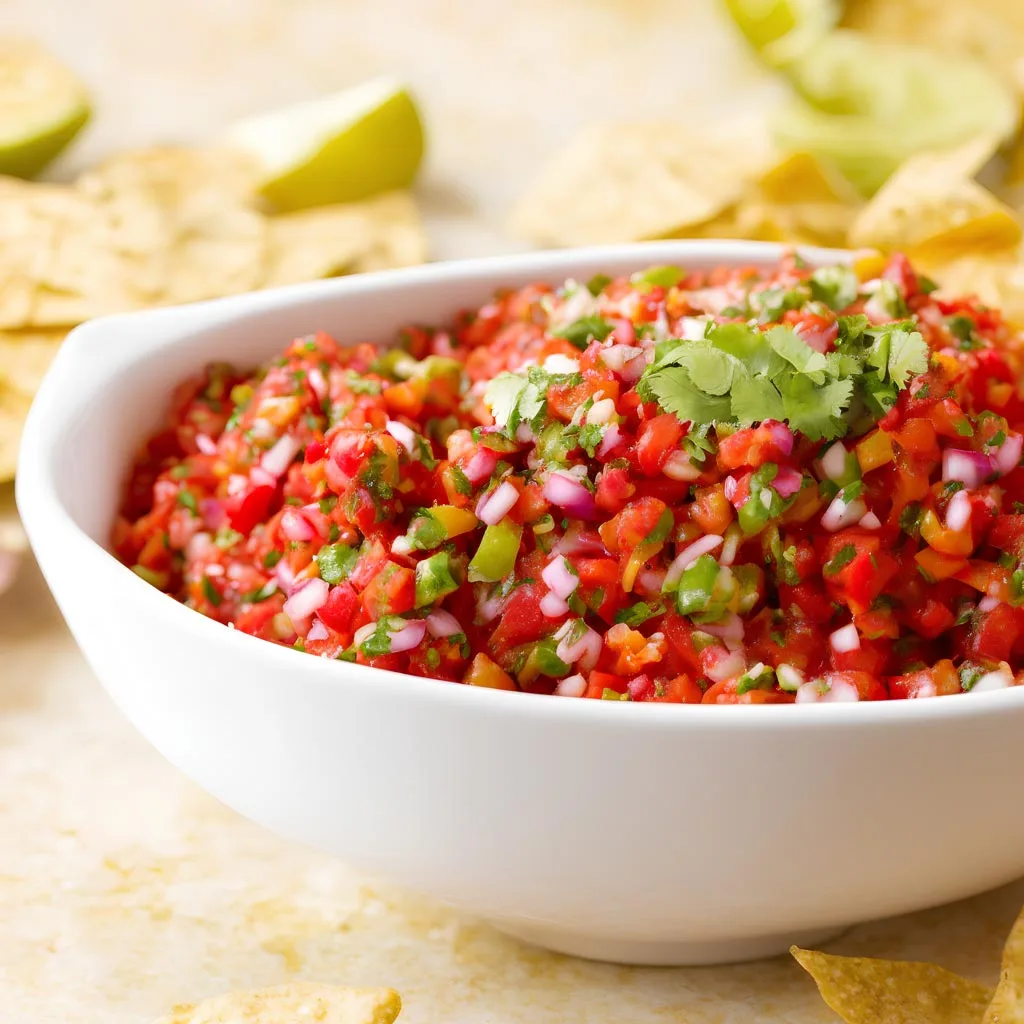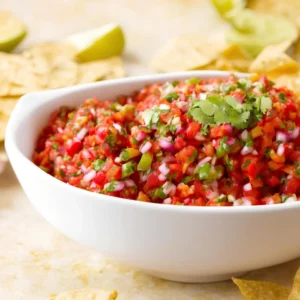
Welcome to a zesty journey into the vibrant flavors of Mexico with this homemade Mexican Salsa recipe. Originating from the heart of Mexican cuisine, this salsa recipe encapsulates the essence of traditional flavors with a modern twist.
Bursting with the freshness of ripe tomatoes, the kick of jalapeños, and the zing of lime juice, this salsa is a quintessential companion to your favorite Mexican dishes or as a standalone snack with tortilla chips.
Crafting your own salsa at home not only allows you to tailor the taste to your preferences but also gives you full control over the quality and freshness of the ingredients. Whether you’re a beginner in the kitchen or a seasoned chef, this recipe offers a delightful balance of simplicity and flavor complexity.
With just a handful of fresh ingredients and a blender, you’ll be amazed at how effortlessly you can whip up a batch of homemade salsa that rivals your favorite restaurant version.
Get ready to tantalize your taste buds with the perfect blend of tangy tomatoes, aromatic cilantro, and spicy jalapeños. Whether you’re hosting a fiesta with friends or simply craving a savory snack, this homemade Mexican Salsa is sure to add a burst of flavor to any occasion.
Expert Tip: Experiment with different varieties of tomatoes and chili peppers to create unique flavor profiles.
Tomatoes: Fresh tomatoes form the base of this salsa, providing a juicy and vibrant flavor that is essential to its authenticity. Their natural sweetness balances the heat from other ingredients, creating a harmonious flavor profile.
Red Onion: Chopped red onion adds a mild, sweet flavor and a crisp texture to the salsa. It complements the tanginess of the tomatoes and adds a pop of color to the dish.
Coriander (Cilantro): Fresh cilantro lends a bright and herbaceous aroma to the salsa, enhancing its freshness and depth of flavor. It adds a refreshing element that elevates the overall taste experience.
Jalapeño: Seeded and finely chopped jalapeño peppers provide a subtle heat to the salsa, infusing it with a spicy kick without overpowering the other flavors. Adjust the amount according to your preferred level of heat.
Garlic: Minced garlic contributes a robust and savory flavor to the salsa, adding depth and complexity. It enhances the overall taste profile and complements the freshness of the other ingredients.
Lime Juice: Fresh lime juice adds a tangy acidity that brightens the flavors of the salsa and helps balance the sweetness of the tomatoes. It also helps preserve the freshness of the salsa and adds a refreshing citrusy note.
Salt: A pinch of salt enhances the flavors of the ingredients, bringing out their natural taste and harmonizing the overall flavor profile of the salsa. Adjust the salt to taste for a perfectly seasoned salsa.
Expert Tip: To add extra depth of flavor, roast the tomatoes, onion, garlic, and jalapeño peppers in the oven before blending them. This will impart a smoky charred flavor to the salsa.
Expert Tip: For a chunkier salsa, pulse the ingredients in the blender until you reach your desired consistency. Avoid over-blending to maintain texture.
Absolutely! In fact, allowing the salsa to sit in the refrigerator for at least 30 minutes before serving enhances the flavors as they meld together. You can also make it a day in advance for even more robust flavor.
When stored in an airtight container, this salsa will stay fresh in the refrigerator for up to 3-4 days. Be sure to give it a good stir before serving if it has been sitting for a while.
Yes, you can easily customize the spiciness of the salsa by adjusting the amount of jalapeño peppers you use. For a milder salsa, remove the seeds and membranes from the jalapeños before chopping them.
While you can freeze salsa, the texture may change slightly upon thawing due to the water content in the tomatoes. It’s best enjoyed fresh, but if you do freeze it, thaw it in the refrigerator and give it a good stir before serving.
Feel free to customize this salsa to your taste preferences. You can substitute fresh tomatoes with canned diced tomatoes if needed, and adjust the quantities of other ingredients according to your liking. Just remember that fresh ingredients yield the best flavor.
Here are some more recipes for you to enjoy! If you my recipes don’t forget to rate and leave a comment.
If you have any recipe suggestions, please do not hesitate to ask me. A great way to stay in contact with me is through Instagram, Facebook, Twitter and YouTube. Don’t forget to tag me @CookwithNabeela in your recipe photos!

Subscribe now to receive my latest recipes directly in your inbox. Stay up-to-date and never miss out!

I love to cook! I want to share with you my favourite, delicious family-friendly recipes. I want to inspire you to create fantastic food for your family every day.
Add your first comment to this post